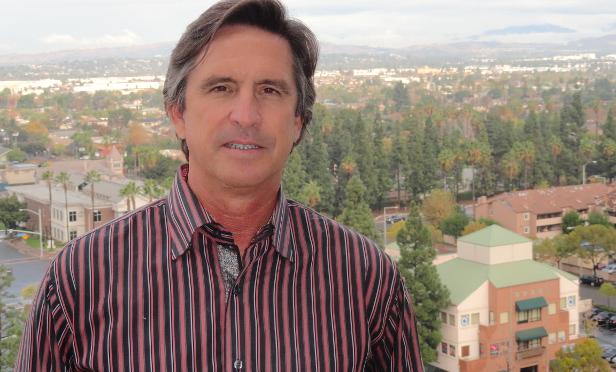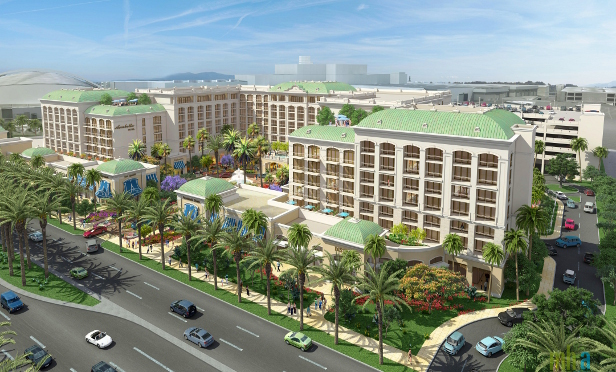
ANAHEIM, CA—Anaheim has a history of taking large geographic areas and planning them out, including creating an entitlement envelope that allows developers to minimize delays, community development director John Woodhead tells GlobeSt.com. As we recently reported, about $6 billion in investment is coming to Anaheim around the city's world-famous theme parks and in and around Angel Stadium of Anaheim. The investment includes the addition of Stars Wars-themed land at Disneyland Park, four new luxury hotels and other lodging, expansion of the Anaheim Convention Center, plus new homes, shopping, dining, offices and hotels at the Platinum Triangle around Angel Stadium. This level of investment in Anaheim is among the largest in the US and reflects ongoing planning by the city of Anaheim to enhance its visitor industry on a global scale and to create an urban village built around sports, entertainment, jobs and public transit.
We spoke exclusively with Woodhead about the expansion, why now is the right time for it and the next steps.
GlobeSt.com: What's behind this expansion in this City of Anaheim?
Woodhead: Anaheim is a little unique in that we like to take large geographic areas and do some sort of planning to try and get them as ready for development as we can, specifically with resort the resort and the Platinum Triangle master land-use plan—we like to update those periodically and create an entitlement envelope within those very large districts. We'll do our CEQA analysis and put all of that in place, so if someone comes in with a project that fits within the window of what we've created, they can get started quite rapidly. This has made the process a lot quicker for them. Time is money to a developer, so this greatly enhances the viability of these areas.
We have done this historically in the resort and made a significant investment in the late '90s when Disney was getting ready to open up a second gate with California Adventure. We cleaned up the streets and set the table for subsequent development. Thousands of keys turned up in the resort in the last cycle. Similarly, in the Platinum Triangle, the master plan was started in 2004 and has been amended several times since. We've analyzed the scope of development and realized the Triangle can provide for 18,000 dwellings, 4.7 million square feet of commercial, 14 million square feet of office and 1.5 million square feet of institutional, which is ARTIC. It can accommodate an awful lot of development.
GlobeSt.com: Why is now the right time for this?
Woodhead: The market is fantastic. If you think about the resort, Disney just had its 60th anniversary, and there's been lots of celebration around that, and a lot of hotel developers wanted to take advantage of that. Financing is back for hotels in the limited-service three-star-hotel sector, so people took advantage of that. When financing for apartments became strong, that led to the rapid development in the Platinum Triangle. Financing for those two sectors has been very strong, and we've created the backdrop against which people can take advantage.

GlobeSt.com: What are the next steps are for this investment?
Woodhead: We—the City of Anaheim and Disney—are trying to take the resort to a whole new level. The resort has reached capacity on a number of days with its theme parks, so the decision to add the Star Wars-themed land made sense. We would like to see significant investment in the resort from the four-diamond hotel market—we haven't had this before, and it will be beneficial in a number of ways to the city. First, it's a segment of hospitality we haven't catered to in the past; there are no four-diamond properties, and we believe we are missing a very important segment of the hospitality market. Also, the convention center is not reaching its full potential number of conventioneers because some are only going to stay at luxury hotels within close proximity to the convention center, so we have missed out on a number of very lucrative conventions. This will have a beneficial effect on the rest of the resort because of the amenities in these hotels that will be available to the public as well as guests. And from a financial standpoint, TOT tax is important to the city for a couple of reasons: 1. it's something we control locally and don't have to look at the vagaries of Sacramento for to see if we're going to receive that in a particular year (we've seen what Sacramento has done with sales tax, vehicle license fees, etc.); 2. TOT is a creature of our own creation, and we control that. TOT accounts for 25% of our general fund and can be used to reinvest in our neighborhoods. If we can enhance that, it will be to the betterment of the entire city.
GlobeSt.com: What else should our readers know about this expansion?
Woodhead: Numbers do a lot of speaking for themselves. It's been a remarkable but long time in the planning stages, and it's a planning effort that Anaheim has long undertaken in many aspects of what we do. We're seeing the fruits of our earlier labor.

ANAHEIM, CA—Anaheim has a history of taking large geographic areas and planning them out, including creating an entitlement envelope that allows developers to minimize delays, community development director John Woodhead tells GlobeSt.com. As we recently reported, about $6 billion in investment is coming to Anaheim around the city's world-famous theme parks and in and around Angel Stadium of Anaheim. The investment includes the addition of Stars Wars-themed land at Disneyland Park, four new luxury hotels and other lodging, expansion of the Anaheim Convention Center, plus new homes, shopping, dining, offices and hotels at the Platinum Triangle around Angel Stadium. This level of investment in Anaheim is among the largest in the US and reflects ongoing planning by the city of Anaheim to enhance its visitor industry on a global scale and to create an urban village built around sports, entertainment, jobs and public transit.
We spoke exclusively with Woodhead about the expansion, why now is the right time for it and the next steps.
GlobeSt.com: What's behind this expansion in this City of Anaheim?
Woodhead: Anaheim is a little unique in that we like to take large geographic areas and do some sort of planning to try and get them as ready for development as we can, specifically with resort the resort and the Platinum Triangle master land-use plan—we like to update those periodically and create an entitlement envelope within those very large districts. We'll do our CEQA analysis and put all of that in place, so if someone comes in with a project that fits within the window of what we've created, they can get started quite rapidly. This has made the process a lot quicker for them. Time is money to a developer, so this greatly enhances the viability of these areas.
We have done this historically in the resort and made a significant investment in the late '90s when Disney was getting ready to open up a second gate with California Adventure. We cleaned up the streets and set the table for subsequent development. Thousands of keys turned up in the resort in the last cycle. Similarly, in the Platinum Triangle, the master plan was started in 2004 and has been amended several times since. We've analyzed the scope of development and realized the Triangle can provide for 18,000 dwellings, 4.7 million square feet of commercial, 14 million square feet of office and 1.5 million square feet of institutional, which is ARTIC. It can accommodate an awful lot of development.
GlobeSt.com: Why is now the right time for this?
Woodhead: The market is fantastic. If you think about the resort, Disney just had its 60th anniversary, and there's been lots of celebration around that, and a lot of hotel developers wanted to take advantage of that. Financing is back for hotels in the limited-service three-star-hotel sector, so people took advantage of that. When financing for apartments became strong, that led to the rapid development in the Platinum Triangle. Financing for those two sectors has been very strong, and we've created the backdrop against which people can take advantage.

GlobeSt.com: What are the next steps are for this investment?
Woodhead: We—the City of Anaheim and Disney—are trying to take the resort to a whole new level. The resort has reached capacity on a number of days with its theme parks, so the decision to add the Star Wars-themed land made sense. We would like to see significant investment in the resort from the four-diamond hotel market—we haven't had this before, and it will be beneficial in a number of ways to the city. First, it's a segment of hospitality we haven't catered to in the past; there are no four-diamond properties, and we believe we are missing a very important segment of the hospitality market. Also, the convention center is not reaching its full potential number of conventioneers because some are only going to stay at luxury hotels within close proximity to the convention center, so we have missed out on a number of very lucrative conventions. This will have a beneficial effect on the rest of the resort because of the amenities in these hotels that will be available to the public as well as guests. And from a financial standpoint, TOT tax is important to the city for a couple of reasons: 1. it's something we control locally and don't have to look at the vagaries of Sacramento for to see if we're going to receive that in a particular year (we've seen what Sacramento has done with sales tax, vehicle license fees, etc.); 2. TOT is a creature of our own creation, and we control that. TOT accounts for 25% of our general fund and can be used to reinvest in our neighborhoods. If we can enhance that, it will be to the betterment of the entire city.
GlobeSt.com: What else should our readers know about this expansion?
Woodhead: Numbers do a lot of speaking for themselves. It's been a remarkable but long time in the planning stages, and it's a planning effort that Anaheim has long undertaken in many aspects of what we do. We're seeing the fruits of our earlier labor.
Want to continue reading?
Become a Free ALM Digital Reader.
Once you are an ALM Digital Member, you’ll receive:
- Breaking commercial real estate news and analysis, on-site and via our newsletters and custom alerts
- Educational webcasts, white papers, and ebooks from industry thought leaders
- Critical coverage of the property casualty insurance and financial advisory markets on our other ALM sites, PropertyCasualty360 and ThinkAdvisor
Already have an account? Sign In Now
*May exclude premium content© 2025 ALM Global, LLC, All Rights Reserved. Request academic re-use from www.copyright.com. All other uses, submit a request to [email protected]. For more information visit Asset & Logo Licensing.








